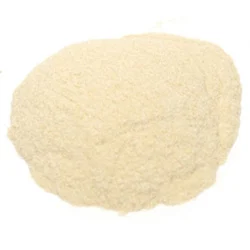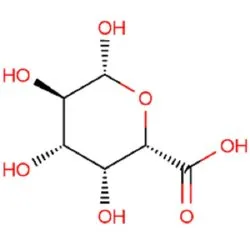Pectin
Synonym(s):Poly-D -galacturonic acid methyl ester
- CAS NO.:9000-69-5
- Empirical Formula: C6H12O6
- Molecular Weight: 0
- MDL number: MFCD00081838
- EINECS: 232-553-0
- SAFETY DATA SHEET (SDS)
- Update Date: 2025-12-17 09:49:38
What is Pectin?
Chemical properties
off-white to beige crystalline powder
Chemical properties
Pectin occurs as a coarse or fine, yellowish-white, odorless powder that has a mucilaginous taste.
Occurrence
Pectin is found in the cell walls of all plants.
The Uses of Pectin
In the preparation of jellies and similar food products: Owens et al., "Factors Influencing Gelation with Pectin" in Natural Plant Hydrocolloids, Advances in Chemistry Series (ACS, Washington, 1954) pp 10-15.
The Uses of Pectin
pectin is used as a thickening agent in cosmetic preparations given its gelling properties. It is soothing and mildly acidic and extracted from apples or the inner portion of citrus fruit rind.
The Uses of Pectin
Pectin is a gum that is the methylated ester of polygacturonic acid. it is obtained from citrus peels and apple pomace. the degree of meth- ylation (dm) or esterification (de) refers to the percentage of acid groups which are present as the methyl ester. pectin is divided into two main groups: high methoxy (hm) pectin, having 50% or greater esterification, and low methoxy (lm) pectin, having less than 50% esterification. these pectins gel under different conditions. the lm pectins are subdivided into low methoxy amidated pectin and low methoxy conventional pectin. see pectin, high methoxy; pectin, low methoxy; amidated pectin.
The Uses of Pectin
Pectinic Acid is a broad group of pectic substances that contain more than a negligible proportion of methyl ester groups and all the unes- terified carboxyl groups are free. the divalent salts of pectinic acid are only slightly soluble in water and must be converted to the sodium or potassium form for dissolution.
What are the applications of Application
Pectin from citrus peel is a galacturonic-rich polysaccharide
Production Methods
Pectin is obtained from the diluted acid extract from the inner portion of the rind of citrus fruits or from apple pomace.
Definition
ChEBI: 2,3,4,5-tetrahydroxypentanal is a pentose, a polyol and a hydroxyaldehyde.
brand name
Adm;Arhemapectin;Astriharina s;Betaine digestive aid;Bio hubber fuerte;Biskapect;Chloropect;Collodyne;Dexinca;Diacalm;Diaguard forte;Diareze;Diarrhosan d;Diastat;Diban diet complex 1500;Diet-trim;Donnagel pg capsule;Donnagel-mb;Donnagel-pg;Enterolyte;Estreptokectil;Estreptonetrol;Estreptoral;Estreptosirup;Fiblet;H.e.c;Kaomagma with pectin;Kaomycin;Kaoneo;Kaopectate n;Kaopectin;Kaoprompt-h;Kao-spen;Kaostaten;Kln;Medipect;Neopec;Norquinol;Noventerol;Orahesive;Pectigels;Pectrolyte;Peterpect;Pomana a;Salvacolina nn;Sorbitoxin;Streptomagma;Varihesive.
World Health Organization (WHO)
Pectin is a purified carbohydrate product isolated from the rinds of citrus fruits or green apples. Its major constituent is polygalacteronic acid, and it is almost completely digested and absorbed in the intestine. Pectin became popular as a simple remedy for diarrhoea in the early 1900s. It does not affect the frequency of stool or stool weight. Use of such products diverts attention away from more important aspects of treatment, such as rehydration, proper nutrition and in the case of cholera and dysentery, appropriate antibiotics.
General Description
Pectin is a polysaccharide is rich in galacturonic acid and possesses a complex structure and function.
Agricultural Uses
Pectin is a high molecular weight polyuronide. It is
related to the carbohydrate family and is present in fruits
and berries.
Pectin occurs in varying amounts in fruits and plants.
It contains carbon, hydrogen and oxygen, and on
hydrolysis, yields glycosides and galachronic acid. It
can form a gel when it absorbs water.
Commercially, the primary source of the commonly
used pectin is lemon and lime peel; other citrus fruits l i e
orange and grapefruit may also be used. Pectin is widely
used in the food industry, principally in gel preparation.
Pectin is also used in making drugs, protective
colloids, emulsifying agents, etc.
Pharmaceutical Applications
present in multi-ingredient preparations for the management of
diarrhea, constipation, and obesity;it has also been used as an
emulsion stabilizer.
Experimentally, pectin has been used in gel formulations for the
oral sustained delivery of ambroxol.Pectin gel beads have been
shown to be an effective medium for controlling the release of a
drug within the gastrointestinal (GI) tract.It has also been used in
a colon-biodegradable pectin matrix with a pH-sensitive polymeric
coating, which retards the onset of drug release, overcoming the problems of pectin solubility in the upper GI tract.Amidated
pectin matrix patches have been investigated for the transdermal
delivery of chloroquine,and gelling pectin formulations for the
oral sustained delivery of paracetamol have been investigated in
situ.Pectin-based matrices with varying degrees of esterification
have been evaluated as oral controlled-release tablets. Lowmethoxy
pectins were shown to have a release rate more sensitive
to the calcium content of the formulation.Pectins have been used
as a component in the preparation of mixed polymer microsphere
systems with the intention of producing controlled drug release.
Biochem/physiol Actions
Pectin, a heterosaccharide component of terrestrial plant cell walls, is used as a substrate to identify, differentiate and characterized pectinase(s). Pectin is used to study its degradation by pectinolytic bacteria.
Safety Profile
Low toxicity by subcutaneous route. When heated to decomposition it emits acrid smoke and irritating fumes.
Safety
Pectin is used in oral pharmaceutical formulations and food
products, and is generally regarded as an essentially nontoxic and
nonirritant material.
Low toxicity by the subcutaneous route has been reported.
LD50 (mouse, SC): 6.4 g/kg
Storage
Pectin is a nonreactive and stable material; it should be stored in a cool, dry place.
Purification Methods
Dissolve the pectin in hot water to give a 1% solution, then cool, and make it to about 0.05M in HCl by addition of conc HCl, and precipitate it by pouring it slowly, with vigorous stirring into two volumes of 95% EtOH. After standing for several hours, the pectin is filtered through a nylon cloth, then redispersed in 95% EtOH and stood overnight. The precipitate is filtered off, washed with EtOH/Et2O, then Et2O and dried in air. [Rees & Walsh Angew Chem, Int Edn 16 214 1977, Rees Adv Carbohydr Chem 24 267 1969.]
Regulatory Status
GRAS listed. Accepted for use as a food additive in Europe. Included in the FDA Inactive Ingredients Database (dental paste; oral powders; topical pastes). Included in the Canadian List of Acceptable Non-medicinal Ingredients. Included in nonparenteral medicines licensed in the UK.
Properties of Pectin
| Melting point: | 174-180 °C (decomp) |
| storage temp. | room temp |
| solubility | H2O: soluble0.02g/10 mL, clear to hazy, colorless to very faintly yellow |
| form | Powder |
| color | Yellow to Pale Brown |
| Odor | wh. to yel. powd. or syrupy conc., pract. odorless |
| Water Solubility | It is soluble in water. |
| Merck | 14,7063 |
| EPA Substance Registry System | Pectin (9000-69-5) |
Safety information for Pectin
Computed Descriptors for Pectin
Pectin manufacturer
New Products
Indole Methyl Resin tert-butyl 9-methoxy-3-azaspiro[5.5]undecane-3-carboxylate Boc-His(Boc)-OH 2-CTC Resin 4-Chloro-7-tosy1-7Hpyrrolo[2,3-d]pyrimidine 5,7-Dibromo-1H-indole 2,5-dichloro-N-hydroxy-4,6-dimethylpyridine-3-carboximidamide 2,2-Dimethoxy-7-azaspiro[3.5]nonane hydrochloride 4-chloromethyl-5-methyl-1,3-dioxol-2-one (DMDO-Cl) R-2-BENZYLOXY PROPIONIC ACID 1,1’-CARBONYLDIIMIDAZOLE 1,1’-CARBONYLDI (1,2-4 TRIAZOLE) N-METHYL INDAZOLE-3-CARBOXYLIC ACID 4-((2-hydroxyethyl)thio)benzoic acid 1-(TERT-BUTOXYCARBONYL)-2-PYRROLIDINONE Methyl 6-methylnicotinate 3-Pyridineacrylic acid tert-Butyl carbazate TETRAHYDRO-2H-PYRAN-3-OL 2-((4-morpholinophenylamino) (methylthio) methylene) malononitrile 3-(4-morpholinophenylamino)-5-amino-1H-pyrazole-4-carbonitrile 2,4-dihydroxybenzaldehyde 1,3-Diethyl-1,3-Diphenylurea Methyl 2-methylquinoline-6-carboxylateRelated products of tetrahydrofuran








You may like
-
 9000-69-5 Pectin 98%View Details
9000-69-5 Pectin 98%View Details
9000-69-5 -
 Pectin CAS 9000-69-5View Details
Pectin CAS 9000-69-5View Details
9000-69-5 -
 Pectin from Citrus CAS 9000-69-5View Details
Pectin from Citrus CAS 9000-69-5View Details
9000-69-5 -
 Pectin pure CAS 9000-69-5View Details
Pectin pure CAS 9000-69-5View Details
9000-69-5 -
 PECTIN Pure CAS 9000-69-5View Details
PECTIN Pure CAS 9000-69-5View Details
9000-69-5 -
 Food Grade Pectin PowderView Details
Food Grade Pectin PowderView Details
9000-69-5 -
 White to Pale Yellow Pectin (CAS Number: 9000-69-5)View Details
White to Pale Yellow Pectin (CAS Number: 9000-69-5)View Details
9000-69-5 -
 Pectin CAS 9000-69-5View Details
Pectin CAS 9000-69-5View Details
9000-69-5
